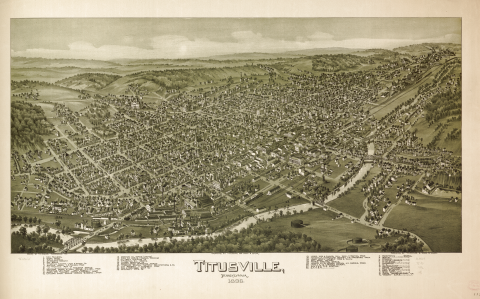Edwin L. Drake, an out-of-work conductor for the New Haven Railroad, went to Titusville in December of 1857 to deal with financial problems associated with the Pennsylvania Rock Oil Company of Connecticut, soon to be the Seneca Oil Company in 1858.
Oil had been coming from a spring on Oil Creek that was used to lubricate machinery and provide smoky light. The technology for producing kerosene from crude oil was been developed and the crude from Titusville was thought to be valuable for this purpose.
In the Spring of 1859 Drake found a salt-well driller willing to come to Titusville, William ‘Uncle Billy’ Smith, a skilled blacksmith who brought with him his fifteen-year-old son as an assistant. Together, they could turn out all the drilling tools needed. But the drilling proved difficult, as the surface soil was quicksand and the bore hole continually flooded. Smith then devised a drill of malleable iron which began to cut through the rock, and when he hitched it up to a steam engine, they were cutting down about three feet a day. Salt wells had been bored to a depth of a thousand feet, so this was nothing. And it produced nothing.
Sunday, 28 August 1859, Uncle Billy Smith found a slick of oil on the surface of the water in the well which was then just over seventy feet deep.
Soon oil was pumping out at eight to ten gallons a day and the problem was finding tubs to hold it. Drake might have become a very rich man, but he did not understand what he had begun. He also had a good deal of bad luck: his derrick and oil storage tanks caught fire that autumn. In any case, he had no idea how to market his oil. With the profits he had made, he sold up and moved to New York, where he lost most of his money in speculation. The world’s first commercial oil well did him no good at all, for Drake died broken and impoverished in 1880.
In 1862, the Oil Creek & Titusville Railroad was built between Titusville and Corry, where the product was transferred to larger east-west railroad lines. In 1865, pipelines were laid directly to the line. The next year the railroad line was extended south to Petroleum Centre and Oil City. The Union & Titusville Railroad was built in 1865. That line became part of the Philadelphia and Erie Railroad in 1871.
From DBD April 2, 1903:
(1819-1880) oil pioneer who had died in obscurity, was disinterred and re-buried in the Woodlawn Cemetery, Titusville, Penn., where H.H. Rogers built a monument to Drake. Among the panels of the monument reads this tribute to Drake’s invention of the drive pipe: “Called by circumstances to the solution of a great mining problem, He triumphantly vindicated American skill and near this spot Laid the foundation of an industry.” Drake is given credit as the first to drill for oil in the US.
